Contents
- Current (through May 30) degree day (DD) Accumulations
- Orchard Radar insect synopsis
- Upcoming meetings
- The way I see it
- Healthy Fruit Special Picture Edition
- Useful links
Current (through May 30) degree day (DD) Accumulations
Location: UMass Cold Spring Orchard (CSO), Belchertown, MA
Base 43: 722
Base 50: 455
Significant upcoming orchard insect events based on degree days (Base 43):
Lesser appleworm 1st flight peak: 355-773
Codling moth 1st flight peak: 574-1008
Obliquebanded leafoller pupae present: 601-821
Obliquebanded leafoller 1st catch: 815-979
European red mite 1st summer eggs: 447-555
Orchard Radar insect synopsis
Note: with each issue of Healthy Fruit we will be reprinting apple insect degree-day model highlights from Glen Koehler's (U. of Maine) Orchard Radar output for Belchertown, MA. You can access the full Orchard Radar output here: http://pronewengland.org/AllModels/DecisionModels.htm
- Codling moth (CM), 1st generation, first sustained trap catch biofix date: May 16, Monday. 1st generation adult emergence at 40% and 1st generation egg hatch at 0%. 1st generation 3% CM egghatch: June 3, Friday = target date for first spray where multiple sprays needed to control 1st generation CM. 1st generation 20% CM hatch = June 10, Friday = target day where one spray needed to control 1st generation CM.
- 1st generation obliquebanded leafroller (OBLR) flight begins around: June 6, Monday.
- Oriental fruit moth (OFM) 1st generation - 55% egg hatch and first treatment date, if needed: May 29, Sunday. 2nd generation OFM flight begins around: June 28, Tuesday. 2nd generation - first treatment date, if needed: July 6, Wednesday.
- Increased risk of Plum Curculio (PC) damage as McIntosh and similar cultivars increase fruit size: May 20, Friday. Earliest safe date for last PC insecticide spray: May 25, Wednesday.
- Spotted Tentiform Leafminer (STLM): 1st generation sapfeeding mines start showing: May 21, Saturday. Optimum sample date is around Monday, May 23, when a larger portion of the mines are visible. 2nd STLM flight begins around: June 12, Sunday.
- Apple sensitivity to post-bloom thinner: Tue. May 31 - Thurs. June 2, Intermediate -- fruit > 18mm are probably beyond predictable chemical thinning due to size and exposure to 2+ days with high temps. > 75F. Fri. June 3 - Sun. June 5, Increased sensitivity -- fruit > 18mm are probably beyond predictable chemical thinning due to size and exposure to 2+ days with high temps. > 75F.
Upcoming meetings
June 14, 15, 16: Tree fruit twilight meeting, TBA
July 18, 2011: Massachusetts Fruit Growers' Association Summer Meeting, Parlee Farms, Tyngsoboro, MA
The way I see it
Enjoy this Special Picture Edition of Healthy Fruit. JC
Healthy Fruit Special Picture Edition
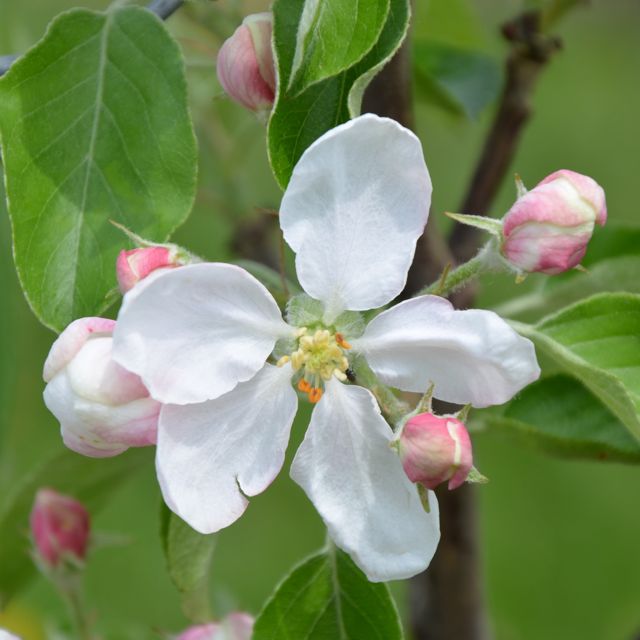 |
Apple bloom and this weather are fire blight heaven. If you have any open bloom (late bloom, just-planted trees), you should be applying streptomycin with any wetting (rain or heavy dew). Or, if you have young trees, remove the bloom during dry weather. Young trees (no fruit) could also get a spray of (low rate) copper. |
Powdery mildew on Honeycrisp apple terminal leaves. Not widespread, but this could be a banner year for mildew. Of particular concern on young trees (stunts terminal shoot growth). The SI fungicide Rally is good control if you see any. Letting it go will result in spread from existing infection(s). |
 |
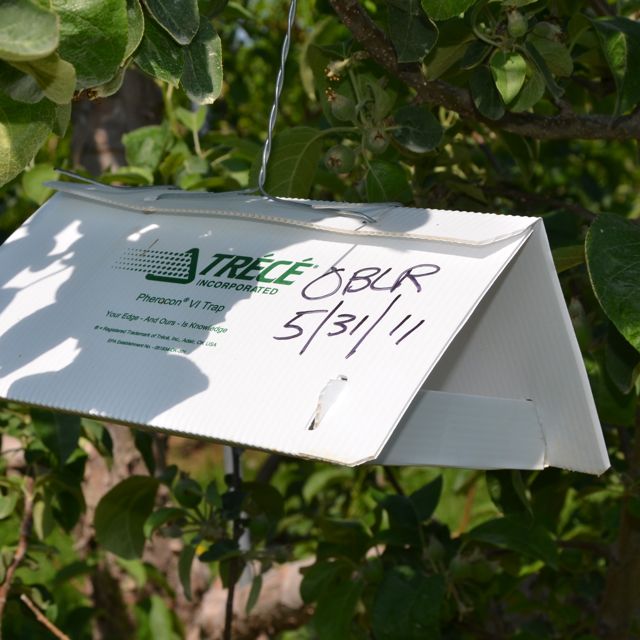 |
Obliquebanded leafroller pheromone traps should be placed in orchard now to ascertain 'biofix' (adult moth catch). Used to determine when to treat upcoming generation of larvae. See 'The obliquebanded leafroller model.' |
'June drop' accompanied by brown rot fungus of cherry. Unless you were insistent with fungicide sprays during the cloudy, wet weather at sweet cherry post-bloom you may be seeing a lot of this. The amount of accompanying brown rot is troublesome this year. You should treat now (once or twice) with the fungicide Pristine and then use Indar during the ripening period to knock-down the brown rot inoculum. |
 |
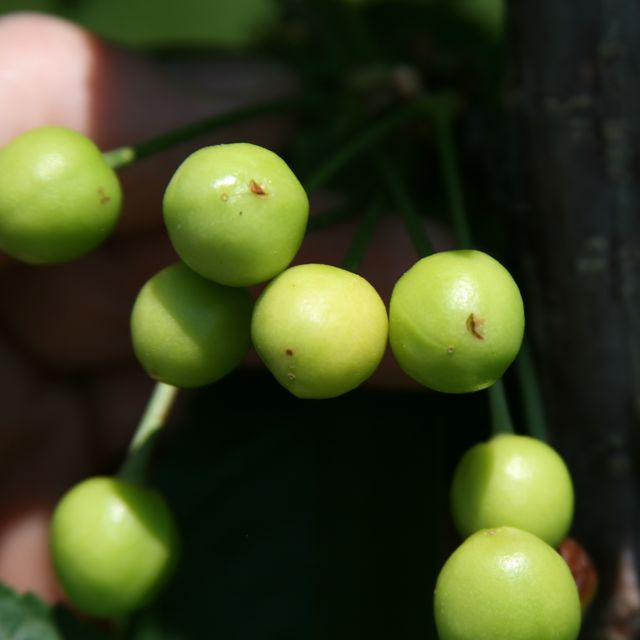 |
Plenty of plum curculio activity on unsprayed sweet cherry. On apple, according to the NEWA website for Belchertown, MA we have reached 209 Degree Days (base 50) from petal fall. Therefore, "Plum curculio activity is beginning to decline and any curculio remaining in trees will usually not move to other locations. Plum curculio only need to be controlled until 308 DD have accumulated after petal fall. Make sure that the predicted residual coverage (10-14 days) from the last spray will protect fruit until DD accumulation reaches this value." (Take home: it's not over yet, but in another week or so it will be.) |
Funny shoot die back on Enterprise apple. First concern fire blight, but not likely. (Enterprise is resistant to fire blight, no likelihood of having shoot blight this early, no oozing.) Turns out such die-back has been observed on Enterprise before and the shoot tips will dry out and that will be the end of it. Don't confuse with Oriental fruit moth damage. And, just because it looks like fire blight, does not mean it is. |
 |
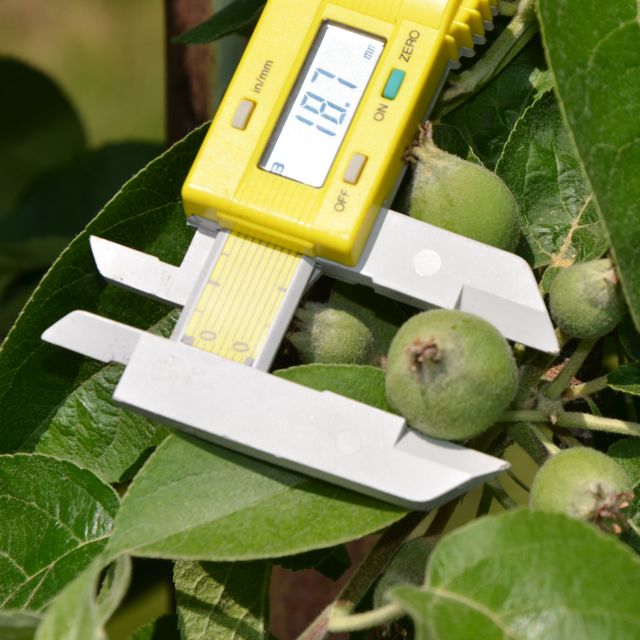 |
Apple fruitlets are approaching the size where they will be come more difficult to thin. If you are still in this hot weather stretch, some thinning is possible still with carbaryl, NAA, or BA. By the end of the week the window will be closed, and only carbaryl and/or ethrel will be left as (not so great) options. Most of you are looking at what you will have now (if the fruit are still growing), although we expect some 'June drop' to continue on previously thinned trees. |
Brown marmorated stink bug (BMSB) monitoring trap at UMass Cold Spring Orchard. The UMass IPM Team has placed several of these around Massachusetts to monitor for BMSB. You should familiarize yourself with the appearance of and how to identify these insects and report any possible findings to us. |
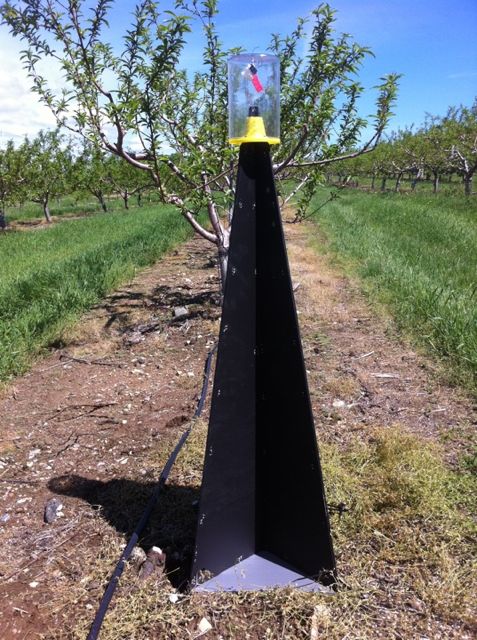 |
Useful links
UMass Fruit Advisor http://www.umass.edu/fruitadvisor/
Scaffolds Fruit Journal http://www.nysaes.cornell.edu/ent/scafolds/
Network for Environment and Weather Applications (NEWA)
JMCEXTMAN Blog http://jmcextman.blogspot.com/
Follow me on Twitter http://twitter.com/jmcextman and Facebook http://www.facebook.com/jmcextman
